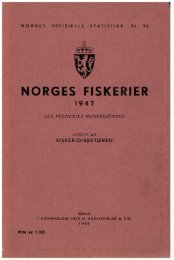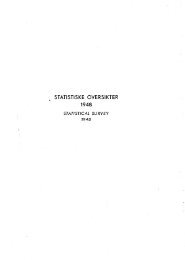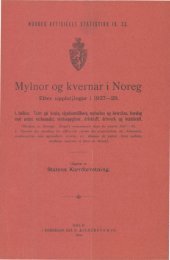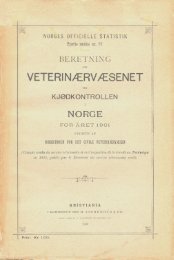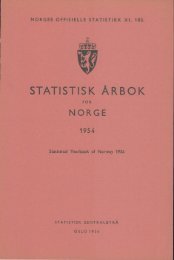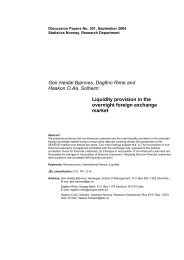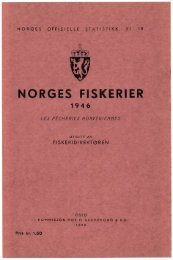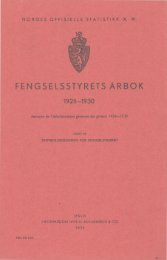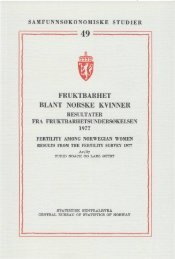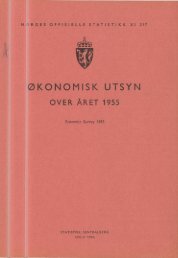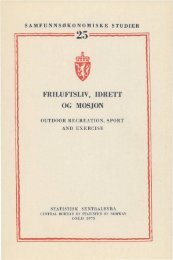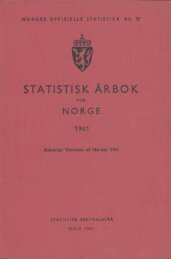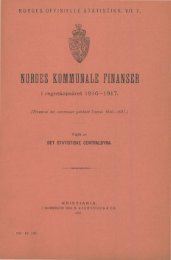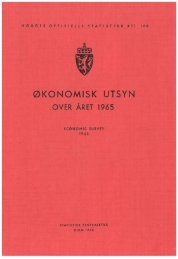XI 190 1954 - Statistisk sentralbyrå
XI 190 1954 - Statistisk sentralbyrå
XI 190 1954 - Statistisk sentralbyrå
You also want an ePaper? Increase the reach of your titles
YUMPU automatically turns print PDFs into web optimized ePapers that Google loves.
Summary. 139<br />
in the ]:1 st weeks of December was great, and<br />
rates •sN ent up to Scale plus 40. At the end of<br />
the yew. nearly all idle ships were again in<br />
operati. )n.<br />
By fir the largest part of the Norwegian<br />
tanker Fleet is sailing on a time charter basis,<br />
and the fall in freight rates affected less than<br />
one fil th of the fleet. This was, however,<br />
sufficiE nt to prevent the earnings of Norwegian<br />
ships in foreign trade from increasing<br />
despite the increase in the fleet.<br />
Earn ngs from commodity exports have<br />
gone u by nearly 13 per cent from 1953 to<br />
<strong>1954</strong>. 1' Ile rise can be attributed wholly to a<br />
rise in volume, since export prices remained<br />
at approximately the same level as in 1953.<br />
Close to 60 per cent of the increment in export<br />
value derives directly or indirectly from the<br />
record output of the herring fisheries. A large<br />
share jH also contributed by the rise in exports<br />
of pul) and paper. Exports have increased<br />
to new ly all countries of any importance as<br />
market:: for Norwegian goods, exept the United<br />
St: tes. Exports to the United States in<br />
<strong>1954</strong> w r. :re 20 per cent lower than the year<br />
before. The sharpest rate of increase has been<br />
in exports to the Soviet Union and some other<br />
countries in Eastern Europe. For total export<br />
earnings this rise is of lesser importance than<br />
the comparatively slower increase in sales to<br />
Western Europa. The Eastern European countries<br />
hive, however, been of great importance<br />
in 195z. as outlets for the large production of<br />
herring and derived products.<br />
The olume of commodity imports, exclusive<br />
of ships, increased by 12 per cent from 1953<br />
to <strong>1954</strong>. Prices have on the average been<br />
considerably lower, and the value of imports<br />
has risen by only 5 per cent. Imports have increased<br />
from nearly all European countries<br />
except t he United Kingdom, but the increase<br />
has be( n particularly great for imports from<br />
the FE leral Republic of Germany. Also, imports<br />
'rom the United States have been<br />
somew 1 tat higher than in 1953. The value of<br />
import-, of some important consumer goods,<br />
like gr tin and sugar, has decreased owing to<br />
lower prices. However, there has been a continued<br />
strong growth in the import value of<br />
most ',tiler consumer goods as well as of<br />
capita] goods. Imports of both machinery and<br />
transp, irtation equipment have increased consideraHy.<br />
The increment in the import value<br />
of ships of more than 40 per cent had important<br />
consequences for the Norwegian balance<br />
of international payments in <strong>1954</strong>.<br />
The total volume of exported goods and<br />
services has, in <strong>1954</strong>, been over 8 per cent<br />
higher than in 1953, while export prices on<br />
the average were only insignificantly higher.<br />
The volume of imports, inclusive of ships, has<br />
gone up approximately 11 per cent, and import<br />
prices have declined by 1.5 per cent. The Norwegian<br />
terms of trade have improved by about<br />
2 per cent. In the external trade of goods only<br />
(exclusive of ships) the improvement in terms<br />
of trade has been considerably greater, viz.<br />
about 6 per cent.<br />
The deficit on the international balance of<br />
goods and services in <strong>1954</strong> is likely to be<br />
somewhat higher than in 1953. It is according<br />
to preliminary estimates, 1 100 million kroner,<br />
as against a little under 1 000 millions in 1953.<br />
To strengthen the reserve of foreign exchange<br />
the Government has borrowed 247 million<br />
kroner abroad in <strong>1954</strong>. Loans on ships have<br />
increased by about 450 million kroner. These<br />
capital imports have, however, been less than<br />
what is needed to cover the excess of imports<br />
over exports of goods and services, and short<br />
term credits abroad have gone up. The Norwegian<br />
debt to the European Payments Union<br />
increased by 170 million kroner in <strong>1954</strong>. This<br />
is the net result of current drawings of 280<br />
million kroner, and repayment on consolidated<br />
debt of 110 million kroner.<br />
The decline in prices of imported goods has<br />
not resulted in a corresponding fall of the<br />
internal price level. The price decline in imported<br />
goods was offset by various factors,<br />
among which the rise in prices of home produced<br />
goods was of prime importance. The<br />
official cost of living index went up by 6<br />
per cent between January and August, mainly<br />
because of price increases in agricultural products<br />
and coffee. It later declined somewhat,<br />
owing to the fall in coffee prices. The rise in<br />
the yearly average of the cost of living index<br />
from 1953 to <strong>1954</strong> has been about 4 per cent.<br />
This index is computed with quantities consumed<br />
by a sample of working-class households<br />
as weights. An alternative method of<br />
measurement which is more inclusive in<br />
coverage showed a smaller rise, namely 2,5<br />
per cent. This alternative is based on the ratio<br />
of current and constant price estimates of<br />
total consumption as estimated in the national<br />
accounts.<br />
During <strong>1954</strong> the scope of price control activities<br />
was greatly reduced. Price regulations<br />
are now maintained only for special commodities<br />
where the prices are still subsidized, or<br />
where special shortages or monopolistic conditions<br />
prevail.<br />
Higher production and prices have led to an<br />
increase in privately earned income of a little<br />
more than 1 200 million kroner, or 7 per cent,<br />
from 1953 to <strong>1954</strong>. Of this increase in income<br />
about 55 per cent have gone to salary and wage<br />
earners, while 45 per cent represent increased



